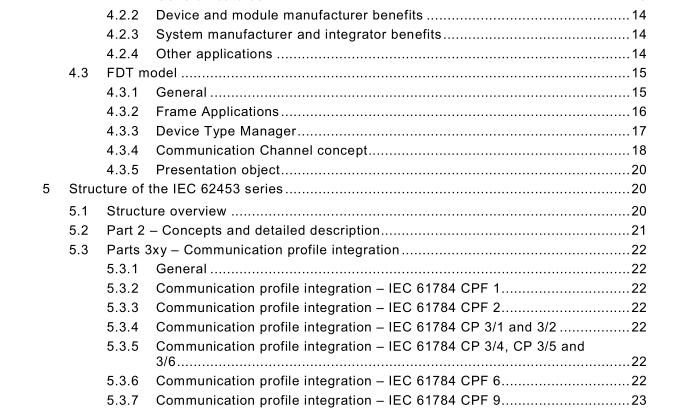IEC 62453-1:2009 pdf download – Field device tool (FDT) interface specification – Part 1: Overview and guidance
Device and module-specific software components are of several types to cover integration of products commonly used in automation systems. DTM objects can, for example, represent normal measurement and control devices. There are specializations of DTMs which represent:
• software entities or function blocks that are movable and may be hosted by different modules in a network, also known as Block DTM (BTM) objects;
• modular equipment combinations, such as I/O stations with plug in boards to provide combinations of I/O and control functions also known as Module DTM objects. A Communication Channel represents the entry point to a fieldbus or point-to-point communication. It provides fieldbus interface independent services. In general, the protocol specific services are mapped to the services provided by the channel. The services may be used by the Frame Application or a DTM to exchange data with a connected device or to initiate a function (e.g. identification request, device reset, broad-cast, etc.). FDT defines the services each of the components has to provide and the data which is exchanged by those. The services are defined in a fieldbus independent way, but some exchange fieldbus specific data. The content and data format for manufacturer independent fieldbuses is defined in the IEC 62453-3xy specifications defining the protocol profile integration in FDT. FDT also enables manufacturers to define their own content and data formats, for example for a manufacturer specific fieldbus or point-to-point communication. The main features of the FDT concept are:
• Frame Application is the representation of the host tool where the DTMs are interacting with the control system, maintenance or engineering application;
• DTM is the main concept and can be applied for simple devices but also for modular devices, software components (function block);
• nested communication is provided to meet the requirement of heterogeneous and hierarchical networks where the intelligent field devices are connected. This is the background for various communication parts in the standard;
• graphical interfaces are provided to provide interactive access to the functionality of the intelligent field devices and its DTM to the human beings. These aspects are represented by so called presentation objects.
4.3.2 Frame Applications Frame Applications provide the runtime environment for the FDT system. Depending on the intended use Frame Applications may have different appearances (e.g. standalone configuration and engineering system). The following general requirements apply to all Frame Applications:
• device and module-specific knowledge is not necessary;
• ability to manage all DTM instances and store instance data;
• ability to manage and create DTM communications and connections (including any necessary message routing);
• guarantee of system-wide consistent configuration;
• enables multi-user and server/client operation (optional);
• takes care of data versions and consistency. FDT is a specification to facilitate the interaction between device-specific objects (i.e. presentation and DTM) and the Frame Application. This is shown in Figure 4.
A Frame Application provides the runtime environment for device specific objects. Typically, the Frame Application comprises client applications that use DTMs, a database for persistent storage of device data, and a communication link to the field devices. Client applications are single applications focusing on specific aspects such as configuration, observation, channel assignment, and using the functionality provided by the DTM as a server.
NOTE The IEC 62453 series distinguishes between the specification of the interactions between objects (e.g. Frame Applications and DTMs) and the implementation technology for the implementation of those objects.
It specifies only the behavior that the objects are expected to provide to client applications that use them.
4.3.3 Device Type Manager DTM objects are supplied by the device manufacturer together with the device. IEC 62453-1 pdf download.
